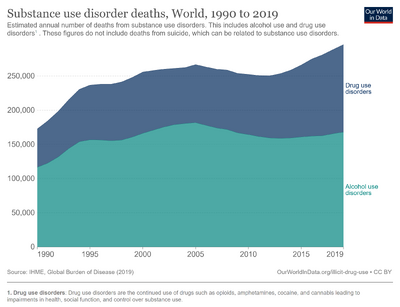Substance intoxication
| Substance intoxication | |
|---|---|
Substance intoxication is a transient condition of altered consciousness and behavior associated with recent use of a substance.[1] It is often maladaptive and impairing, but reversible.[2] If the symptoms are severe, the term "substance intoxication delirium" may be used.[3]
Substance intoxication may often accompany a substance use disorder (SUD); if persistent substance-related problems exist, SUD is the preferred diagnosis.[4]
The term "intoxicated", used by laymen, most often refers to alcohol.
Classification
The ICD-10 Mental and Behavioural Disorders due to psychoactive substance use shows:[5]
- F10. alcohol
- F11. opioids
- F12. cannabinoids
- F13. sedatives and hypnotics
- F14. cocaine
- F15. caffeine
- F16. hallucinogens
- F17. tobacco
- F18. volatile solvent
- F19. multiple drug use and use of other psychoactive substances
Caffeine
The discussion over whether the coffee (caffeine) “buzz” counted as intoxication or not was hotly debated during the early to mid 16th century.[6]
Contact high
Contact high is a phenomenon that occurs in otherwise sober people who experience a drug-like effect just by coming into contact with someone who is under the influence of a psychoactive drug. In a similar way to the placebo effect, a contact high may be caused by classical conditioning as well as by the physical and social setting.[7][8] The phenomenon is most commonly reported within the context of psychedelic drug use and may be related to the comparable phenomenon of synchronicity.
The term is often incorrectly used to describe the high obtained from passive inhalation of marijuana.[8][9]
Etymology
Slang terms
Slang terms include: getting high (generic), being stoned, cooked, or blazed (usually in reference to cannabis),[10] and many more specific slang terms for particular intoxicants. Alcohol intoxication is graded in intensity from buzzed, to tipsy (all the way up to drunk, hammered, plastered, smashed, wasted, destroyed, shitfaced and a number of other terms). The term rolling is a common word used to describe being under the influence of MDMA and for LSD the phrases frying or tripping have been used. “Tripping” is a term that is considered applicable to virtually all hallucinogens which includes psychedelics, dissociatives, deliriants and possibly certain types of hypnotics.
See also
References
- ↑ Michael B. First; Allan Tasman (2 October 2009). Clinical Guide to the Diagnosis and Treatment of Mental Disorders. John Wiley and Sons. pp. 146–. ISBN 978-0-470-74520-5. Retrieved 27 April 2010.
- ↑ Michael B. First; Allen Frances; Harold Alan Pincus (2004). DSM-IV-TR guidebook. American Psychiatric Pub. pp. 135–. ISBN 978-1-58562-068-5. Retrieved 27 April 2010.
- ↑ William H. Reid; Michael G. Wise (26 August 1995). DSM-IV training guide. Psychology Press. pp. 80–. ISBN 978-0-87630-768-7. Retrieved 27 April 2010.
- ↑ "Acute intoxication". World Health Organization. Archived from the original on July 4, 2004. Retrieved 2020-01-31.
- ↑ Drs; Sartorius, Norman; Henderson, A.S.; Strotzka, H.; Lipowski, Z.; Yu-cun, Shen; You-xin, Xu; Strömgren, E.; Glatzel, J.; Kühne, G.-E.; Misès, R.; Soldatos, C.R.; Pull, C.B.; Giel, R.; Jegede, R.; Malt, U.; Nadzharov, R.A.; Smulevitch, A.B.; Hagberg, B.; Perris, C.; Scharfetter, C.; Clare, A.; Cooper, J.E.; Corbett, J.A.; Griffith Edwards, J.; Gelder, M.; Goldberg, D.; Gossop, M.; Graham, P.; Kendell, R.E.; Marks, I.; Russell, G.; Rutter, M.; Shepherd, M.; West, D.J.; Wing, J.; Wing, L.; Neki, J.S.; Benson, F.; Cantwell, D.; Guze, S.; Helzer, J.; Holzman, P.; Kleinman, A.; Kupfer, D.J.; Mezzich, J.; Spitzer, R.; Lokar, J. "The ICD-10 Classification of Mental and Behavioural Disorders Clinical descriptions and diagnostic guidelines" (PDF). www.who.int World Health Organization. Microsoft Word. bluebook.doc. p. 65-76. Archived (PDF) from the original on 23 March 2014. Retrieved 24 June 2021 – via Microsoft Bing.
- ↑ Brown, Daniel W. (2004). A new introduction to Islam. Chichester, West Sussex: Wiley-Blackwell. pp. 149–51. ISBN 978-1-4051-5807-7.
- ↑ Bozzetti, L. (1968). "Dr. Bozzetti Replies". American Journal of Psychiatry. 124 (11). doi:10.1176/ajp.124.11.1600-b. Archived from the original on 2023-08-02. Retrieved 2023-07-25.
- ↑ 8.0 8.1 Olson, Jay A.; Suissa-Rocheleau, Léah; Lifshitz, Michael; Raz, Amir; Veissière, Samuel P. L. (2020). "Tripping on nothing: Placebo psychedelics and contextual factors". Psychopharmacology. 237 (5): 1371–1382. doi:10.1007/s00213-020-05464-5. PMID 32144438. S2CID 212577549. Archived from the original on 2023-08-02. Retrieved 2023-07-25.
- ↑ Keup, Wolfram (Jan 1971). "The Vocabulary of the Drug User and Alcoholic: A Glossary". International Journal of the Addictions. 6 (2): 353. doi:10.3109/10826087109057793. PMID 4950517. Archived from the original on 2023-08-02. Retrieved 2023-07-25.
- ↑ Johnson BD, Bardhi F, Sifaneck SJ, Dunlap E (2005). "Marijuana Argot As Subculture Threads". British Journal of Criminology. 46 (1): 46–77. doi:10.1093/bjc/azi053. Archived from the original on 2023-07-15. Retrieved 2023-07-25.
{{cite journal}}: CS1 maint: multiple names: authors list (link)
External links
| Classification |
|---|
| Look up substance intoxication in Wiktionary, the free dictionary. |

